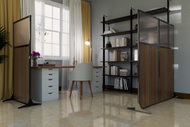How to Clean and Maintain Your Office Partitions
Posted by Kate Murphy on Aug 5th 2025
Cleaning might not be the most thrilling task on your to-do list, but when it comes to your office partitions, a little upkeep goes a long way. These quiet workhorses divide spaces, absorb sound, and help define your layout—but they also collect dust, fingerprints, and the occasional coffee splash.
Often overlooked during routine cleaning, partitions are high-contact surfaces that deserve more attention than they get. Whether they’re fabric, acrylic, or laminate, giving them regular care helps extend their lifespan, maintain their appearance, and contribute to a healthier, more polished work environment.
This guide covers everything you need to know about how to clean office partitions and keep them in top shape—with straightforward advice, material-specific tips, and a few smart shortcuts to make the process less of a chore.
Why Office Partition Hygiene Matters
Office partitions help organize and define workspaces, creating structure between desks, meeting areas, and shared zones. However, while doing their job, partitions can quietly collect dust, allergens, fingerprints, smudges, and germs from frequent contact.
In fact, the average office desk harbors around 10 million bacteria—approximately 400 times more than a typical toilet seat. High-touch surfaces like desks, door handles, keyboards, phones, and room dividers are hotspots for microbes that cause colds, flu, and other infections.
Regular cleaning of these surfaces limits the spread of germs, resulting in healthier employees and fewer sick days, which helps keep productivity on track. Additionally, dust, mold, and allergens accumulate over time, reducing indoor air quality and causing respiratory issues. Routine dusting and vacuuming help maintain cleaner air and support overall employee health.
Beyond physical health, a clean and well-maintained workspace boosts morale. Walking into a tidy, sanitary environment signals that employees’ well-being matters, fostering loyalty and job satisfaction. Conversely, clutter and dirt increase stress, while an organized space promotes calm, focus, and mental clarity—leading to better decisions and improved productivity.
Finally, regular cleaning preserves partition materials by preventing discoloration, warping, and premature wear, extending their lifespan and maintaining a professional appearance.
Basic Cleaning Tools and Supplies You’ll Need
Before you begin, gather supplies suitable for your specific partition type. Here's a general list:
- Microfiber or nonabrasive cloths and sponges (to avoid scratches and streaks)
- Soft-bristled brush or vacuum with brush attachment (for fabric)
- Spray bottles filled with appropriate cleaning solutions
- Mild, nonabrasive detergents and soaps
- White vinegar or diluted dish soap (for acrylic and laminate)
- Rubber gloves for protection
- Disinfecting wipes (as long as they’re compatible with the surface)
Avoid harsh chemicals like bleach, ammonia, or alcohol-based cleaners unless you’re certain the material can handle it.
Recognizing Your Office Partition Material
Not all partitions are made alike. Cleaning methods vary based on the material:
- Fabric: Can absorb moisture and is prone to staining
- Polycarbonate, acrylic glass, clear plastic, plexiglass: Prone to scratches and chemical damage
- Glass: Easy to disinfect but may show streaks
- Laminate, wood: Sensitive to water exposure and needs gentle handling
Knowing your partition’s material is essential. If you're unsure, check product specifications or reach out to your supplier for clarification.
Step-by-Step Cleaning for Common Partition Materials
Cleaning office partitions doesn’t have to be complicated. Follow these simple steps, tips, and guidelines tailored to the most common materials to keep your workspace fresh and looking sharp.
Fabric Partitions
- For dust, hair, and other dry debris, vacuum panels with an upholstery or brush attachment.
- To spot clean fabric panels, dampen a nonabrasive cloth or soft nylon brush with a mild water-based soap and water solution. Lightly brush the working area, careful to avoid over-dampening the fabric’s surface. Towel dry after cleaning.
- If using a fabric cleaner for spot treatment, lightly mist the area to loosen soil before cleaning. Always test cleaners in an inconspicuous area first.
- For a deeper clean, consider using an upholstery or steam cleaner. Let the fabric dry completely to prevent mildew.
Note: Versare’s thicker SoundSorb™ material is colorfast and chemical-resistant; however, it’s still recommended to follow the above fabric cleaning guidelines to maintain its durability and appearance.
Polycarbonate, Clear Plastic, Acrylic, or Plexiglass Partitions
- The easiest and safest way to clean this type of material is with a mild soap, such as a dish washing liquid, using a nonabrasive cloth or sponge.
- To disinfect, use a diluted bleach solution; the CDC recommends a disinfecting bleach solution of 1/3 cup to 1 gallon water.
- Avoid using ammonia or alcohol-based products (Windex or Lysol), as well as paper towels, as they may damage the surface or coating of the panels over time.
Laminate or Wood Partitions
- Wipe down with a damp (not wet) microfiber cloth and mild soap.
- Dry immediately to prevent streaks or water damage.
- Check edges and seams regularly—these areas are prone to hidden dirt and mold buildup.
Setting a Cleaning and Maintenance Schedule
A regular cleaning routine keeps office partitions in good shape and cuts down on the need for deep cleaning. Even a simple schedule helps maintain their look and cleanliness.
On a daily basis, high-touch surfaces—especially acrylic or laminate panels—should be wiped down to remove smudges, germs, and buildup. This quick task helps prevent the spread of illness and keeps partitions looking polished.
Weekly, it's a good idea to dust or vacuum fabric panels and check for debris in corners, bases, or seams where dirt tends to accumulate.
Every quarter, plan a deeper clean. This might include spot-cleaning or steam-cleaning fabric surfaces and inspecting the structure of your partitions for loose hardware, warping, or other signs of wear.
Cleaning responsibilities can be shared. While your janitorial staff may handle the more involved tasks, employees can assist with basic upkeep, such as wiping down their own work areas. For shared spaces, accountability tools like signage or a cleaning checklist can help ensure nothing gets overlooked and everyone does their part.
Preventive Maintenance Tips to Extend Partition Life
Keeping your office partitions clean is important, but regular maintenance can help them last even longer. Using desk guards or liners near shared workstations can prevent buildup on panels. Improving airflow with fans or air purifiers also helps reduce dust settling on surfaces.
It’s a good idea to check your partitions regularly for loose parts, chipped corners, or panels that feel unsteady. Also, avoid taping or pinning items directly onto acrylic or laminate panels, as this can cause damage.
When to Repair or Replace Your Office Partitions
Regular cleaning and maintenance can extend the life of your office partitions—but not indefinitely. Over time, wear and tear can impact both their appearance and performance. Knowing when to repair versus replace helps you maintain a professional environment while saving time and money.
Signs it may be time to replace include torn or fraying fabric, persistent stains, or cloudy, scratched, or cracked acrylic panels. These issues not only affect aesthetics but can also compromise hygiene, visibility, and safety.
Structural concerns like warped panels, loose connections, or mold and mildew often signal deeper problems or neglect. In such cases, repairs may only delay the inevitable, and continued use could impact both safety and air quality.
From a cost perspective, repeated spot cleaning, repairs, or replacements of parts can add up quickly. At a certain point, investing in new, durable partitions is the more economical and practical choice—especially when considering the improved appearance, functionality, and health standards new models provide.
If your partitions are starting to show their age, it might be the perfect time to refresh your space. Versare’s office partitions and cubicles are designed with long-lasting materials, modular features, and easy maintenance in mind—making them a smart, stylish upgrade for any workplace.
Keep Your Workspace Clean, Functional, and Professional
Whether you’re leading a team or welcoming clients, a tidy, well-maintained space speaks volumes—it says, we care, and we pay attention to the details.
Luckily, keeping things fresh doesn’t have to be a hassle. With low-maintenance, easy-to-clean partitions—like those from Versare—staying polished becomes a simple part of your daily routine, not an overwhelming deep-clean panic.
Need help choosing a partition that fits your space and maintenance preferences? Contact Versare for personalized recommendations or explore office-friendly options today.


